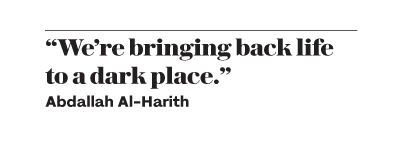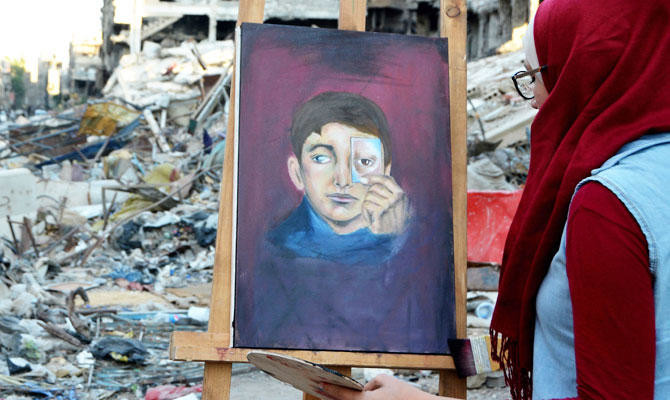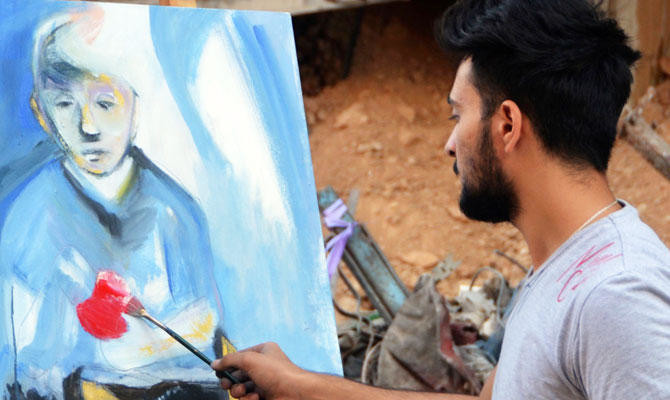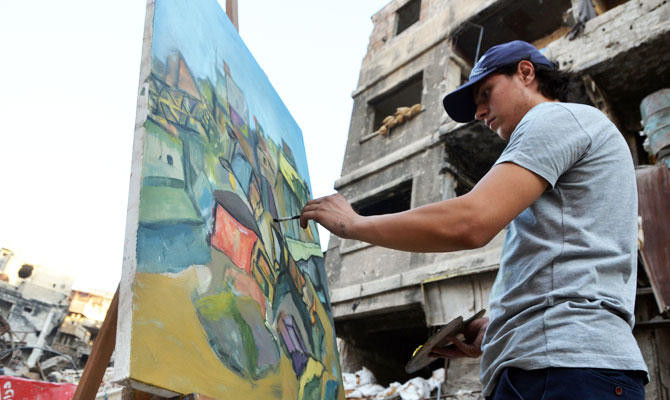YARMUK, Syria: Not far from his destroyed home in Syria’s Yarmuk camp for Palestinian refugees, 21-year-old Abdallah Al-Harith dabs bright red paint onto a canvas standing amid the grey ruins.
Last week, he was among 12 young artists to set up their easels in the once-crowded camp turned Damascus suburb, now largely abandoned after seven years of civil war.
Equipped with paint brushes and pencils, they set out to translate suffering into art in a neighborhood ravaged by years of bombardment and siege.
“We’re bringing back life to a dark place,” said Harith, who fled Yarmuk several years ago, but returned after the regime ousted Daesh group jihadists in May.
“I had such a lump in my throat when I first came back to the camp. At first I couldn’t draw anything,” said the fine arts student.
“But then I realized that any glimpse of life amid all this death was a victory,” he said, gesturing toward the battered buildings around him.
He and his peers stood sweeping paint across their canvases while the gentle melody of an oud — a Middle Eastern lute — was broadcast across the smashed concrete. Harith painted an image of a small boy emerging from the ground, holding a bright red apple.
“It’s supposed to represent new life,” Harith said. 
“I actually saw something like this once: children with apples playing again on what had been fighting ground.”
Before the war, Yarmuk was home to around 160,000 people, the United Nations says.
Set up in 1957 to house Palestinian refugees, over the decades it became a crowded district that was eventually swallowed up by Damascus.
But today it lies almost abandoned. Around 140,000 residents fled clashes between the regime and rebels in 2012, leaving the rest to face severe food shortages under government encirclement. In 2014, a harrowing photograph of gaunt-looking residents massing between ravaged buildings to receive handouts caused global outrage.
Earlier this year, fighting between loyalists and jihadists displaced most of the remaining residents, according to the United Nations’ agency for Palestinian refugees, UNRWA.
President Bashar Assad’s troops retook control in May, ousting IS fighters from their last urban stronghold on the outskirts of the capital.
In late May, UNRWA said an immediate return of residents was unlikely due to extensive damage to key infrastructure such as the water and power networks.
Visiting the camp last month, UNRWA commissioner-general Pierre Krahenbuhl said he had rarely seen such damage.
“The scale of the destruction in Yarmuk compares to very little else that I have seen in many years of humanitarian work in conflict zones,” he said.
On Saturday, the work of the young artists was displayed at the entrance of the Yarmuk camp, with a small crowd making the trip to see it.
Painter Hinaya Kebabi depicted a young boy with a missing eye, holding up a drawing of another eye to conceal his wound, the 22-year-old explained.
“One day, I hope people will come back here to color, not rubble,” she said.
One painting depicted streams of red running down a dark building.
In another, an emaciated man was curled up naked in the foetal position.
After the images were shared online, several Internet users slammed the project as provocative.
“The camp is neither romantic nor a place for drawing,” 28-year-old Abeer Abassiyeh said, as most former residents remain unable to return to their homes.
But Mohammed Jalbout, one of the organizers who hails from the Palestinian camp, defended the project.
“We all have homes here. I haven’t been back to mine or been able to inspect it,” he said.
But, he said, “at least through art, we’re trying to breathe a little life back into this place.”
In Syria’s Yarmuk, artists paint amid the ruins
In Syria’s Yarmuk, artists paint amid the ruins

- Around 140,000 residents fled clashes between the regime and rebels in 2012, leaving the rest to face severe food shortages under government encirclement
- Set up in 1957 to house Palestinian refugees, over the decades it became a crowded district that was eventually swallowed up by Damascus
Miniature model helps bring Saudi history to life

- Featuring miniature representations of Saudi cities from the past, these creations transport visitors through time
- Artist and craft trainer Abdullah Al-Khazam, a native of Hail, presented a clay model of the ancient commercial area of Hail city at the event
RIYADH: The Beit Hail Festival, which runs until July 29, is showcasing unique works which reflect the region’s rich historic archaeological legacy, the Saudi Press Agency has reported.
Featuring miniature representations of Saudi cities from the past, these creations transport visitors through time, highlighting the details of daily life and the beauty of historic architecture.
Artist and craft trainer Abdullah Al-Khazam, a native of Hail, has presented a clay model of the ancient commercial area of Hail city at the event.
The model has attracted the attention of thousands of visitors and illustrates the techniques used to craft such works, enriching the festival’s depiction of the Kingdom’s heritage.
Al-Khazam based the model on historic sources, using precise measurements and conducting field visits. He also consulted historians, researchers, and elderly residents for accuracy.
The model features key landmarks, including Barzan Palace, a mosque, the commercial square, and various government offices, the SPA added.
Built with traditional materials such as clay and palm trunks, the model uses classic construction techniques and incorporates period ornaments and engravings, effectively recreating the city center of the past.
The UK’s longest-running Arab arts festival returns

DHAHRAN: The Liverpool Arab Arts Festival, or LAAF, the UK’s longest-running annual celebration of Arab arts and culture, returns this month with a theme that feels both timely and timeless: “Nostalgia.”
Now two decades in, the festival has grown from grassroots beginnings into an internationally recognized celebration.
Running through to July 20, this year’s program explores how memory, heritage and longing shape artistic expression across the Arab world and its diasporas.
The dynamic, bilingual line-up spans film, music, literature, performance, food and family activities — all underscored by deeper reflections on identity, loss and cultural continuity.
Arab News spoke with Taher Qassim, originally from Yemen, who founded LAAF in 1998 as a community-led effort to foster cultural pride and preserve Arab identity in Liverpool.
“The theme of ‘nostalgia’ is a reflection of both how far we’ve come and where we began,” Qassim said. “Twenty-three years ago, we set out on a path that was uncertain but filled with excitement and purpose. We knew we wanted to create something that represented the Yemeni and Arab presence in Liverpool, but we didn’t yet know how to express it.”
What began as a handful of cultural activations has since evolved into a platform for Arab artists. “From those humble beginnings … the festival began to blossom,” he said. “Today, we proudly offer a platform to artists from across the Arab world, Europe, the US, and beyond — something we could only have dreamed of.”
Two events stand out for him: ‘Arabs Are Not Funny’ and ‘The Book of Sanaa.’ The former, he says, “directly challenges the long-held stereotype that Arabs lack a sense of humor. It’s refreshing, bold and liberating — exactly what the festival stands for.”
The latter brings together literature, poetry, food, and a model of Yemen’s historic capital.
“The richness of this event would’ve felt like a fantasy to us two decades ago. Now, it’s a reality — something we’ve made possible through years of dedication and community.”
Qassim, who was awarded an MBE (Member of the Order of the British Empire) in 2008 for services to community cohesion, handed over the festival’s leadership to his daughter, Afrah, who now steers LAAF with the same vision and care.
Today, LAAF is no longer seen solely as a festival for the Arab community. “That perception has shifted dramatically,” Qassim said. “People from all backgrounds and ages attend and engage. The festival has become a space for dialogue, curiosity and connection.” As he put it, “Conversations happen naturally — before, during and after events.”
One event he hopes visitors will not miss is the now-iconic “Family Day” at the Palm House in Sefton Park. “It’s become the signature event of the Liverpool Arab Arts Festival — our legacy day,” he said. “Families travel from across the UK, Europe, and even further afield to be part of it. The atmosphere is joyful, welcoming, and truly inclusive … a vibrant, heartwarming celebration of Arab culture at its best.”
Some events require tickets, but “Family Day” — an afternoon of music, crafts, performances and community — is the grand finale and free to all.
Christie’s London to feature retrospective on Syrian artist Marwan

DUBAI: Christie’s is poised to host a non-selling exhibition of work by late Syrian artist Marwan Kassab-Bachi, titled “Marwan: A Soul in Exile.”
Taking place from July 16- August 22, the show was curated by Ridha Moumni, chairman of Christie’s Middle East & Africa.
This retrospective exhibition will display more than 150 works on loan from museums, institutions and private collections in Europe and the Middle East. The exhibition traces the artist’s career, from his artistic beginnings in Syria to his prolific output in Germany, his adopted homeland, where he spent six decades of his life.
“I wanted to highlight the essential threads running through his career: from his iconic ‘Face Landscapes’ to the celebrated ‘Heads,’ his journey from Damascus to Germany, and the pivotal moments that shaped his legacy — including his major 1976 retrospective at Charlottenburg Schloss, which established his place in the German art scene,” Moumni told Arab News.
“Equally important is his enduring connection to Syria and the Arab world,” he added.
With paintings, works on paper, and editions from 1953 until 2014, this exhibition offers audiences in London the chance to explore the artist’s multi-disciplinary approach.
“Over the past two years, our aim has been to introduce artists and artistic scenes to London that people here don’t often get to see. One of our deepest commitments is to highlight the richness of artists from the Arab world or of Arab heritage. Marwan embodies this mission beautifully: a towering figure from the Syrian diaspora, who built an extraordinary career in Germany, and had a big impact on modern portraiture,” Moumni said of Christie’s decision to spotlight the artist this summer.
In 1957, Marwan moved to Berlin and attended the Hochschule fur Bildende Kunste, graduating in 1963. The artist, who is referred to by his first name, joined a group of German expressionist painters that included Georg Baselitz and Eugen Schonebeck, but he retained his Syrian identity and engaged with social and political issues of the Middle East through his work.
“For those who already know his work, I hope they uncover new depths — its poetic power, its meditations on exile, identity, and belonging. Above all, I hope visitors feel a true connection to Marwan’s work,” Moumni said.
Artist Dan Pearce explores kinetic energy in Doha artwork

- Steel sculpture captures water dropping onto a surface
- Doha peninsula was inspiration, Pearce tells Arab News
DUBAI: Internationally-acclaimed London-based artist Dan Pearce has revealed the inspiration for his work to mark the 20th anniversary of the Four Seasons Hotel Doha, titled “Kinetic Drop.”
Known for commissions from French football icon Paul Pogba, other celebrities and global exhibitions, the artist’s bespoke sculpture is crafted from stainless steel.
“I titled this sculpture ‘Kinetic Drop’ because it captures that precise moment when a water droplet collides with a surface, that split second when kinetic energy disperses in all directions,” Pearce told Arab News recently.
“With all my work, I aim to trigger one of three responses: to make viewers think ‘how did he do that?’ to inspire them to touch the artwork, or to encourage movement around the piece for different perspectives,” he added.
The artist, who was born in Australia, is known for his pop culture-inspired work and often turns to DC Comics, musicians and street art for source material.
Taking inspiration from the hotel and its surroundings in Doha may have been a welcome departure for the artist. “The sculpture is mounted on a map of Qatar.
“Geographically, Qatar is also surrounded by water as a peninsula while Four Seasons Doha is situated on the Arabian Gulf where I could see endless views of the shimmering waters from our room — this was also part of the inspiration behind the piece,” he explained.
As for the location of the artwork, the artist said it “could create a sense of urgency and exclusivity, encouraging visitors and guests to interact and connect with it on a social level and experience it before it’s gone.”
Pearce’s work has captured the attention of celebrities and worldwide brands, with commissioned pieces for boxing champion Anthony Joshua, Grammy nominee Rag’n’Bone Man, and hip-hop star 50 Cent, to name a few.
Ensuring his work can be understood across cultures is something that was particularly important to Pearce in the run-up to his showcase in Doha.
“With the concept of the sculpture being water, this makes it universally significant across all cultures. Water represents life, renewal, and connection which are key elements that can transcend cultural boundaries,” he said.
Superman fans claim film is critical of Israel

DUBAI: James Gunn’s new “Superman” film is drawing attention online for what many viewers interpret as a pointed political message.
A scene showing a heavily armed military force attacking civilians across a border, where children’s lives are at risk, has sparked comparisons to the Israel-Gaza war.
While neither Gunn nor the cast have stated the film references Israel or Palestine, early audiences have drawn their own conclusions, suggesting the conflict serves as an allegorical backdrop.
One user wrote on X: “Y’all were not kidding about how anti-Israel and pro-Palestine that superman movie was, and they were not slick with it AT ALL,” while another said: “Superman was so openly anti-Israel and god it was so good.”
Another user said: “Not going to lie I really like the anti-Israel sentiment from superman and now I know James Gunn is always standing on business.”
Though the film never names specific nations, Gunn has said in interviews that it tackles themes of “politics” and “morality,” and positions Superman as an immigrant, comments that have also sparked backlash from some US conservatives.
The film is a reboot of the DC franchise and marks the beginning of Gunn’s new DC Universe. It stars David Corenswet as Clark Kent/Superman and Rachel Brosnahan as Lois Lane. The cast also includes Nicholas Hoult as Lex Luthor and Isabela Merced as Hawkgirl.
The movie was released in Saudi Arabia on July 10.


















